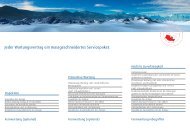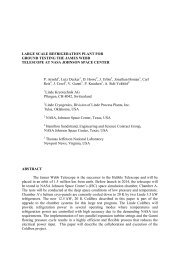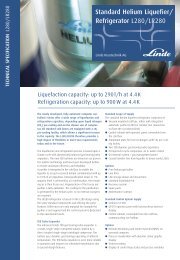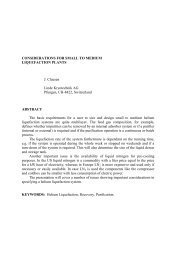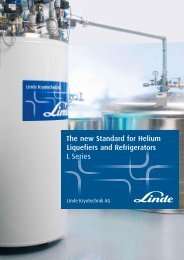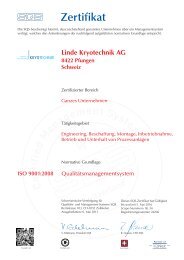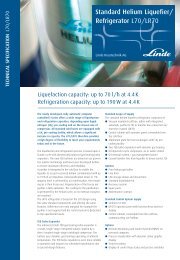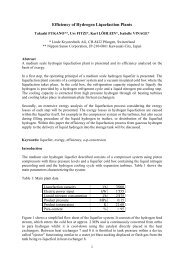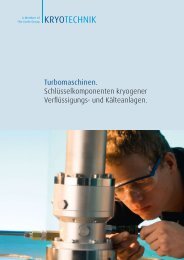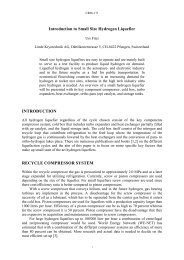Microsoft Word - ICEC_23_NN09_Paper - Linde JLAB final.doc
Microsoft Word - ICEC_23_NN09_Paper - Linde JLAB final.doc
Microsoft Word - ICEC_23_NN09_Paper - Linde JLAB final.doc
Create successful ePaper yourself
Turn your PDF publications into a flip-book with our unique Google optimized e-Paper software.
4.5-K Refrigerator Cold Box System for the 12 GeV Upgrade at JLab<br />
ARNOLD, PH., KNUDSEN, P.*<br />
<strong>Linde</strong> Kryotechnik AG, Daettlikoner Strasse 5, 8422 Pfungen, Switzerland<br />
* Thomas Jefferson National Accelerator Facility (JLab), 12000 Jefferson Ave, Newport News, Virginia<br />
<strong>23</strong>606, USA<br />
In September 2009 <strong>Linde</strong> Cryogenics, a division of <strong>Linde</strong> Process Plants, Tulsa, Oklahoma,<br />
was awarded the contract to deliver an 18 kW 4.5-K equivalent refrigerator system to JLab in<br />
Newport News, Virginia. This system includes upper (300 to 60-K) and lower (60 to 4.5-K)<br />
cold boxes, interconnecting transfer lines and auxiliary equipment. <strong>Linde</strong> Kryotechnik AG<br />
will supply seven large dynamic gas bearing expansion turbines and the engineering design<br />
for this refrigerator. In conjunction with JLab’s second 2.1-K cold box, this refrigerator<br />
system will allow JLab to double its current 2.1-K refrigeration capacity of 4600 W as part of<br />
the accelerator upgrade to 12 GeV.<br />
BACKGROUND<br />
As shown in Figure 1, the present Central Helium Liquefier (CHL-1) at JLab supports 22-1/4 cryomodules<br />
(using SRF Niobium cavities) in a ‘north’ LINAC, 20 in a ‘south’ LINAC and 3-1/4 at the Free-<br />
Electron Laser (FEL). The CHL-1 operates in conjunction with a 2.1-K cold box which houses five stages<br />
of centrifugal cold compressors [1]. The new 4.5-K cold box (CHL-2) will operate with a duplicate 2.1-K<br />
cold box. In the 12 GeV configuration, five new style cryomodules will be added to the north and five to<br />
the south LINAC, doubling the total LINAC load [2]. Both new and old 4.5-K and 2.1-K cold boxes will<br />
have approximately the same capacity, with one supporting the north LINAC and the other the south<br />
LINAC and the FEL [3].<br />
DESIGN BASIS AND PERFORMANCE DATA<br />
Table 1 presents an abbreviated summary of JLab’s specification for the cold box design basis. It consists<br />
of six different operational (design) modes defined to promote a balanced design by ensuring a proper<br />
selection of the expanders and heat exchangers thereby avoiding in the design unnecessary performance<br />
limitations and plant inefficiencies at off-design mode and/or load operation. However, the utility of the
design modes is limited to the design phase. For commissioning and operation a ‘mode’ concept will not<br />
be implemented since the plant will find its optimal working point for the applied load automatically [4].<br />
Rather, by using the floating pressure – Ganni cycle (licensed to <strong>Linde</strong>) in cooperation with the <strong>Linde</strong><br />
dynamic gas bearing turbines and the presented flexibility of the plant, a high overall system efficiency<br />
can be maintained automatically (i.e., without manual intervention, except for intentional shut-down of<br />
equipment in extreme capacity reduction cases) and in a very simple manner for any potential ‘modes’<br />
and loads.<br />
Table 1 Design modes (abbreviated) per customer specification [5]<br />
# Design Mode Load @ Load @ Liquefaction Load @<br />
2 K [g/s] * 4.5 K [kW] [g/s] 30 K [kW]<br />
1 Maximum capacity (CBX supporting<br />
maximum cold compressor operation) ><strong>23</strong>8 0 >15 >12<br />
2 Nominal capacity (CBX supporting nominal<br />
cold compressor operation) >200 0 0 >7.5<br />
3 Maximum 4.5-K liquefaction 0 0 >150 >7.5<br />
4 Maximum 4.5-K refrigeration 0 >10.5 0 >12<br />
5 Maximum fill (of Linac cryo-modules) >200 0 >35 >12<br />
6 Stand-by 4.5-K refrigeration** 0 >2.5 0 >12<br />
* Load at 2.1 K means supply flow at 3.2 bar 4.5 K, with return flow at 1.2 bar 30 K<br />
** Mode 6 requires a minimum amount of rotating equipment while supporting the LINAC loads at 4.5-K.<br />
Figure 1 Installation of new refrigeration plant at <strong>JLAB</strong><br />
As required by the JLab specification [5], the objective of the CBX design was to achieve a<br />
maximum total 4.5-K plant exergetic efficiency for all design modes by using a minimum number of<br />
compressors from a specified set of compressor frame sizes and operating with a specified set of<br />
isothermal and volumetric efficiencies that are a function of the stage (low or high) and the pressure ratio<br />
(similar to [6]). Also, estimate motor efficiencies were specified and it was required that all compressors<br />
in each stage utilize the same frame size. Since the CBX uses LN pre-cooling, the equivalent input power
for this utility was determined from the exergy provided by the LN and a (assumed) production efficiency<br />
of 35%. So, although the compressor system was not within <strong>Linde</strong>’s scope of work, the CBX design<br />
compelled its selection in a manner that would optimize the total 4.5-K plant efficiency. In Figure 2 the<br />
design modes are ordered by total load exergy and plotted together with the expected exergetic<br />
efficiencies of the cold box (CBX) and total 4.5-K plant (i.e., CBX, LN and compressor system)<br />
efficiency.<br />
Exergy [kW]<br />
1600<br />
1400<br />
1200<br />
1000<br />
800<br />
600<br />
400<br />
200<br />
0<br />
1 5 3 2 4 6<br />
Design Mode<br />
100<br />
90<br />
80<br />
70<br />
60<br />
50<br />
40<br />
30<br />
20<br />
10<br />
0<br />
Ė @ 2.1 K Ė @ Liq Ė @ 4.5 K<br />
Exergetic efficiency [%]<br />
Ė @ 35 K η_total [%] η_CBX [%]<br />
Figure 2 Load exergies and expected efficiencies<br />
FURTHER DESIGN CONSIDERATIONS AND SELECTED FEATURES<br />
The refrigerator consists of two CBX’s, one “upper” CBX for the temperature range of 300 to 60-K and<br />
one “lower” CBX for the range of 60 to 4.5-K (see Figure 3). By separating the refrigerator into two<br />
CBX’s, existing site space allocation constraints are eased, on-site installation cost and complexity is<br />
greatly reduced, the long heat exchangers (HX’s) in the upper CBX can be oriented vertically in a single<br />
core and the expansion turbines in the lower cold box can be located indoors inside a horizontal cold box<br />
facilitating access for maintenance. All HX’s in the upper and lower CBX’s will be installed vertically<br />
with the warm-end upwards; an ideal situation that is often inhibited by site constraints. The upper CBX<br />
utilizes LN pre-cooling in the configuration of a thermo-siphon and is arranged to ensure proper phaseseparation<br />
thereby allowing minimal LN usage [7]. The 300 to 80-K helium-helium HX is quite long and<br />
separate from the 300 to 80-K high-pressure helium-nitrogen HX. In conjunction with flow balancing<br />
valves this will also promote minimal LN usage [7]. Although, for process reasons it is preferable to split<br />
the upper and lower CBX’s at the 80-K temperature level to allow the interconnecting transfer-line heat<br />
leak to be adsorbed by the LN, the 80 to 60-K HX could not be reasonably fit into the required lower<br />
CBX prescribed size constraints. For mode 1, the HX’s have 54.5 total NTU’s between 300 to 80-K, 50.6<br />
total NTU’s between 80 to 30-K and 43.1 total NTU’s between 30 to 4.5-K. Per the customer’s<br />
specification [5], HX lengths were kept to (approximately) less than 10 NTU’s per meter (of effective
length) and pressure drop ratio’s between (a) core to distributors and (b) core plus distributors to headers<br />
plus nozzles to (approximately) at least a factor of three. This is intended counter any flow maldistribution<br />
as a result of unintended manufacture peculiarities and/or reduced flow at a capacity turndown<br />
condition (to approximately 30%).<br />
Figure 3 Process flow diagram<br />
To ensure maximum efficiency, for modes1 and 2 (the primary design modes) the temperature ratio<br />
of the expansion stages below 30-K (the cold compressor return temperature) were selected to result in<br />
roughly equal turbine (string) mass flows [8]. Of course, since compressor displacements are not a<br />
continuous variable, some slight adjustments are necessary to accommodate the selected compressor<br />
frame sizes. Although sophisticated process analysis was employed (due to non-ideal fluid properties and<br />
component complexities) to select the cycle and analyze component requirements necessary for an<br />
optimal design, in fact, a simple ‘Carnot Step’ analysis [8] can predict the optimum expansion stage flows<br />
and temperature ratios quite reasonably. In Figure 4, the design modes are ordered by the supply pressure<br />
to the CBX which is the same order as by total load exergy in Figure 2. Apart from the first turbine flow<br />
which is principally used to cool the thermal shield between 35 and 55 K, in load cases that consist<br />
primarily of the 2.1-K load and/or 4.5-K liquefaction, the turbine flows are close to each other for each<br />
temperature stage. Load cases that consist primarily of 4.5-K refrigeration, such as modes 4 and 6, exhibit<br />
more unequal expansion stage mass flows (and temperature ratios) since this type of load does not<br />
inherently require an imbalance [9] and the non-ideal fluid properties contribute a much larger fraction of<br />
the availability supplied to the CBX. As indicated in Figure 4, for a compressor capacity based upon<br />
mode 1, it is advantageous to utilize the JT turbine (TU7) bypass in other modes for optimal efficiency<br />
(for a given compressor capacity).<br />
Table 2 summarizes the flexibilities built into the refrigerator to provide robustness and an ability to<br />
operate over a wide range load conditions and diverse kinds of modes.
Mass Flow [g/s]<br />
1600<br />
1400<br />
1200<br />
1000<br />
800<br />
600<br />
400<br />
200<br />
0<br />
1 5 3 2 4 6<br />
Design Mode<br />
20<br />
18<br />
16<br />
14<br />
12<br />
10<br />
8<br />
6<br />
4<br />
2<br />
0<br />
Pressure [bar]<br />
TU1-2 Stage TU3-4 Stage TU5-6 Stage<br />
TU7 Stage TU7 Bypass CBX Inlet<br />
Figure 4 Turbine mass flows and Supply Pressure to CBX<br />
Table 2 Refrigerator flexibilities<br />
Refrigeration of each turbine string can be modulated while maintaining near optimal speed without adjusting the inlet valve<br />
by adjusting the system charge. Inlet valves will only operate under greatly reduced capacity conditions, 4.5 K refrigeration<br />
or for turbine protection.<br />
Each turbine string can be independently shut-down, isolated, cleaned or replaced, then brought back on-line.<br />
To assist in capacity when required, the JT expander can be bypassed by any amount with minimal peturbation to the supply<br />
with the incorporation of an upstream HX (located upstream of the bypass valve to achieve a more optimal cooling curve).<br />
Three configurations for thermal shield cooling are possible (see Figure 3). The thermal shield may be cooled by way of the<br />
first turbine string (TU1-2), the second turbine string (TU3-4) or the LN pre- cooling stage.<br />
Refrigerator can continue to operate, although at a reduced capacity, if there is a LN utility failure.<br />
LN pre-cooler can utilize the sensible nitrogen vapor from the 2.1-K CBX cold compressor motors.<br />
Dual 80-K adsorber beds can be independently isolated, regenerated and then brought back on-line. Also, both beds can be<br />
bypassed if necessary.<br />
20-K adsorber bed can be bypassed while being isolated, regenerated and then brought back on-line.<br />
SUMMARY<br />
An extended process analysis at the beginning of the project for the various design modes has allowed the<br />
development of a plant with high efficiency for all design modes and considerable robustness and<br />
flexibility for diverse kinds of modes and a wide range of load adaptation. Presently, the refrigerator is<br />
scheduled to be delivered the fall of 2011. This collaboration between JLab, <strong>Linde</strong> Cryogenics and <strong>Linde</strong><br />
Kryotechnik AG has proven to be quite successful to date.
ACKNOWLEDGMENTS<br />
This work was supported by the U.S. Department of Energy under contract no. DE-AC05-06OR<strong>23</strong>177.<br />
REFERENCES<br />
1. Ganni, V., et al., Design, Fabrication, Commissioning and Testing of a 250 g/s 2 K Helium Cold Compressor System,<br />
Advances in Cryogenic Engineering (2002) 47A 288-304<br />
2. Cardman, L.S., Harwood, L., The JLab 12 GeV Energy Upgrade of CEBAF for QCD and Hadronic Physics, Proceedings<br />
of 21 st Particle Accelerator Conference, Albuquerque, New Mexico (2007)<br />
3. Arenius, D., et al, Overview and Status of the 12 GeV Cryogenic System Upgrade at JLab, Advances in Cryogenic<br />
Engineering (2010) 55 1087-1091<br />
4. Ganni, V., Knudsen, P., Optimal Design and Operation of Helium Refrigeration Systems Using the Ganni Cycle,<br />
Advances in Cryogenic Engineering (2010) 55 1057-1071<br />
5. Dixon, K., et al, Technical Specification for the Procurement of CHL-II 4.5 K Cold Box System for the 12 GeV Upgrade<br />
at Thomas Jefferson National Accelerator Facility (2008)<br />
6. Ganni, V., et al, Screw Compressor Characteristics for Helium Refrigeration Systems, Advances in Cryogenic<br />
Engineering (2008) 53 309-315<br />
7. Knudsen, P., Ganni, V., Helium Refrigerator Liquid Nitrogen Pre-Cooler Component Parameter Sensitivity Analysis,<br />
Advances in Cryogenic Engineering (2010) 55 215-222<br />
8. Knudsen, P., Ganni, V., Simplified Helium Refrigeration Cycle Analysis using the ‘Carnot Step’, Advances in Cryogenic<br />
Engineering (2006) 51 1977-1986<br />
9. Quack, H., Maximum Efficiency of Helium Refrigeration Cycles Using Non-Ideal Components, Advances in Cryogenic<br />
Engineering (1994) 39 1209-1216



